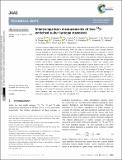| dc.contributor.author | Ono, Shuhei | |
| dc.date.accessioned | 2020-04-24T15:10:14Z | |
| dc.date.available | 2020-04-24T15:10:14Z | |
| dc.date.issued | 2019-03 | |
| dc.date.submitted | 2019-01 | |
| dc.identifier.issn | 0267-9477 | |
| dc.identifier.issn | 1364-5544 | |
| dc.identifier.uri | https://hdl.handle.net/1721.1/124850 | |
| dc.description.abstract | Despite widespread applications of sulfur isotope mass-independent fractionation (MIF) signals for probing terrestrial and extra-terrestrial environments, there has been no international sulfur isotope reference material available for normalization of Δ33S and Δ36S data. International reference materials to anchor isotope values are useful for interlaboratory data comparisons and are needed to evaluate, e.g., whether issues exist associated with blanks and mass spectrometry when using different analytical approaches. We synthesized two sodium sulfate samples enriched in 33S with different magnitudes, and termed them S-MIF-1 and S-MIF-2, respectively. The sulfur isotopic compositions of these two samples were measured in five different laboratories using two distinct techniques to place them on the V-CDT scale for δ34S and a provisional V-CDT scale for Δ33S and Δ36S. We obtained average δ34S values of S-MIF-1 = 10.26 ± 0.22‰ and S-MIF-2 = 21.53 ± 0.26‰ (1σ, versus V-CDT). The average Δ33S and Δ36S values of S-MIF-1 were determined to be 9.54 ± 0.09‰ and -0.11 ± 0.25‰, respectively, while the average Δ33S and Δ36S values of S-MIF-2 are 11.39 ± 0.08‰ and -0.33 ± 0.13‰ (1σ, versus V-CDT). The lack of variation among the interlaboratory isotopic values suggests sufficient homogeneity of S-MIF-1 and S-MIF-2, especially for Δ33S. Although additional measurements may be needed to ensure the accuracy of the isotopic compositions of S-MIF-1 and S-MIF-2, they can serve as working standards for routine Δ33S analysis to improve data consistency, and have the potential to serve as secondary sulfur isotope reference materials to address issues such as scale contraction/expansion and for normalization and reporting of Δ33S and Δ36S between laboratories. For the same reasons as listed for sulfur isotopes, the same standards were also artificially enriched in 17O. The calibration is still in progress but first estimations gave Δ17O = 3.3 ± 0.3‰ with unassigned δ18O. ©2019 | en_US |
| dc.language.iso | en | |
| dc.publisher | Royal Society of Chemistry (RSC) | en_US |
| dc.relation.isversionof | 10.1039/C8JA00451J | en_US |
| dc.rights | Creative Commons Attribution 3.0 unported license | en_US |
| dc.rights.uri | https://creativecommons.org/licenses/by/3.0/ | en_US |
| dc.source | Royal Society of Chemistry (RSC) | en_US |
| dc.title | Intercomparison measurements of two 33 S-enriched sulfur isotope standards | en_US |
| dc.type | Article | en_US |
| dc.identifier.citation | Gen, L., et al., "Intercomparison measurements of two 33 S-enriched sulfur isotope standards." Journal of analytical atomic spectrometry 34, 6 (Mar. 2019): no. 1263 doi 10.1039/C8JA00451J ©2019 Author(s) | en_US |
| dc.contributor.department | Massachusetts Institute of Technology. Department of Earth, Atmospheric, and Planetary Sciences | en_US |
| dc.relation.journal | Journal of analytical atomic spectrometry | en_US |
| dc.eprint.version | Final published version | en_US |
| dc.type.uri | http://purl.org/eprint/type/JournalArticle | en_US |
| eprint.status | http://purl.org/eprint/status/PeerReviewed | en_US |
| dc.date.updated | 2020-04-06T19:38:11Z | |
| dspace.orderedauthors | L. Gen; J. Savarino; N. Caillon; E. Gautier; J. Farquhar; J.W. Dottin III; N. Magalhaes; ˜S. Hattori; S. Ishino; N. Yoshida; F. Albarede; E. Albalat; P. Cartigny; Ono, Shuhei; M.H. Thiemensh | en_US |
| dspace.date.submission | 2020-04-06T19:38:13Z | |
| mit.journal.volume | 34 | en_US |
| mit.journal.issue | 6 | en_US |
| mit.license | PUBLISHER_CC | |
| mit.metadata.status | Complete | |
